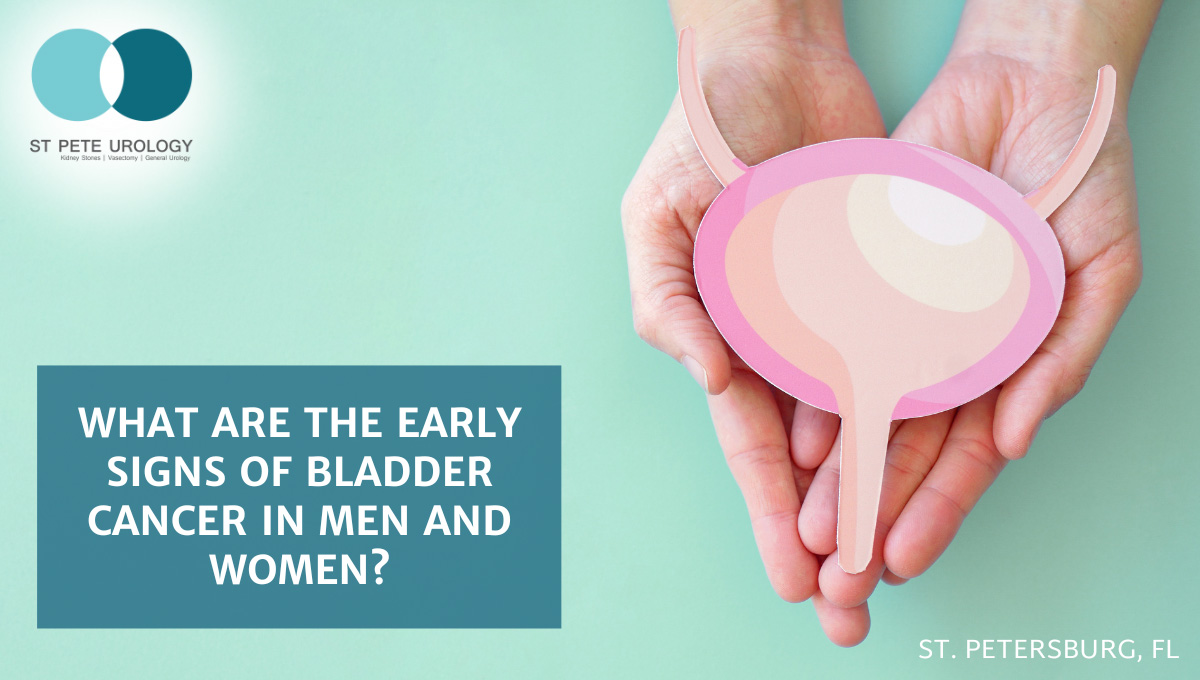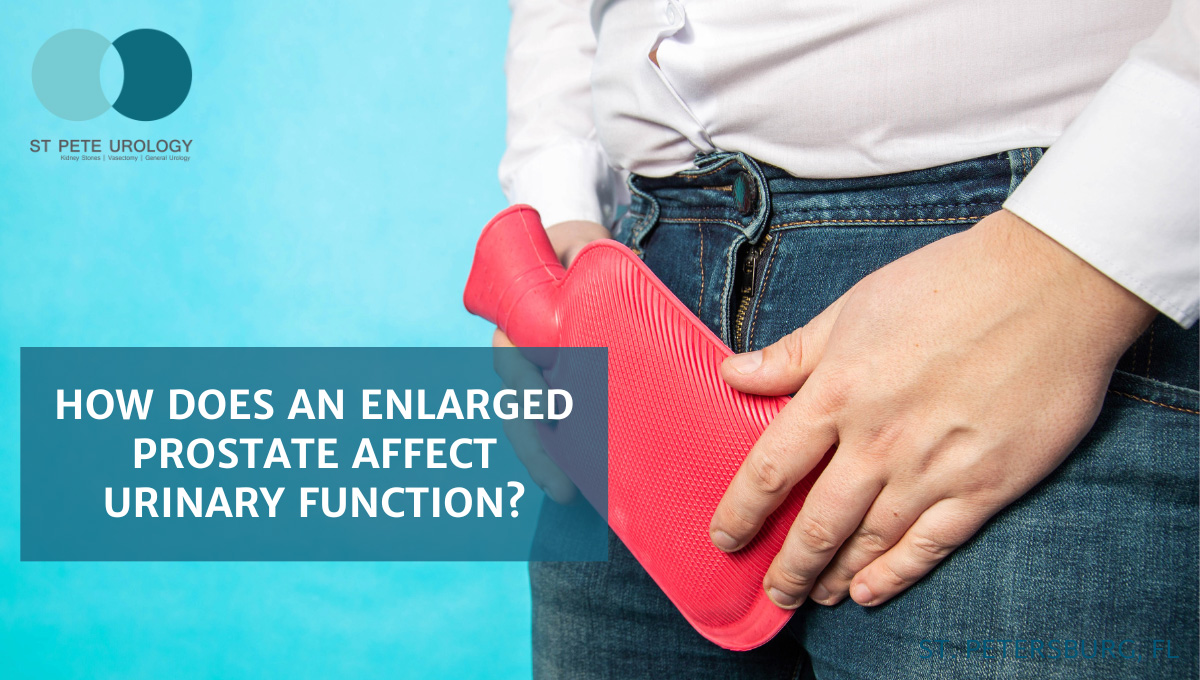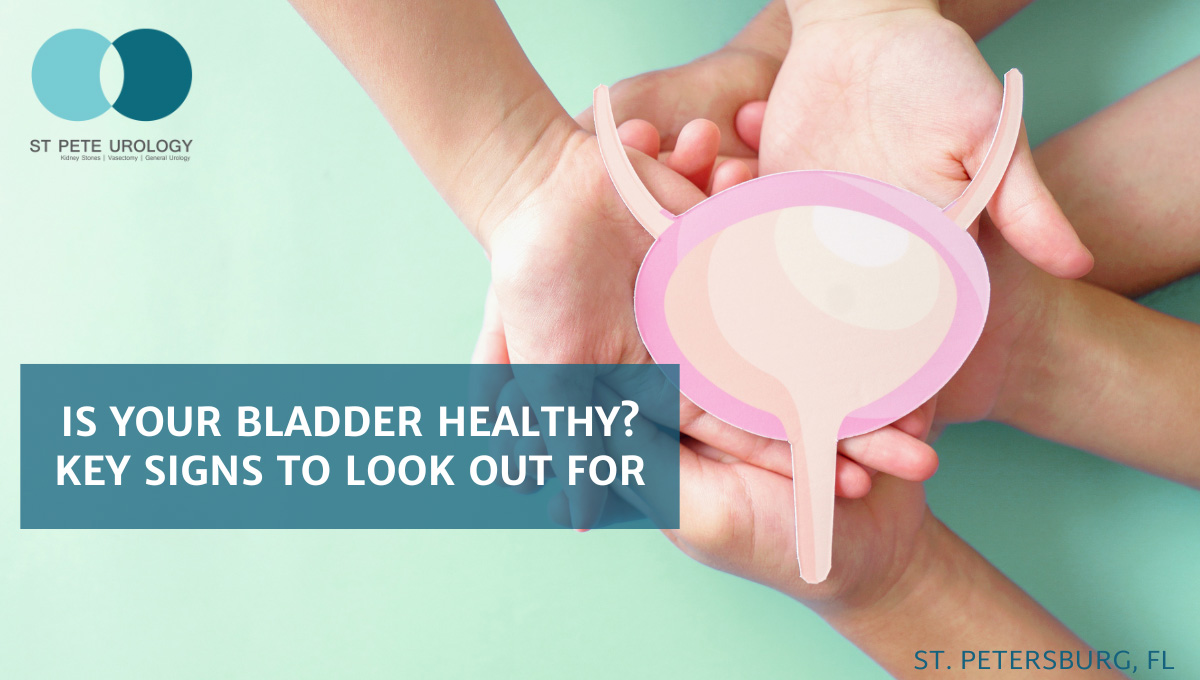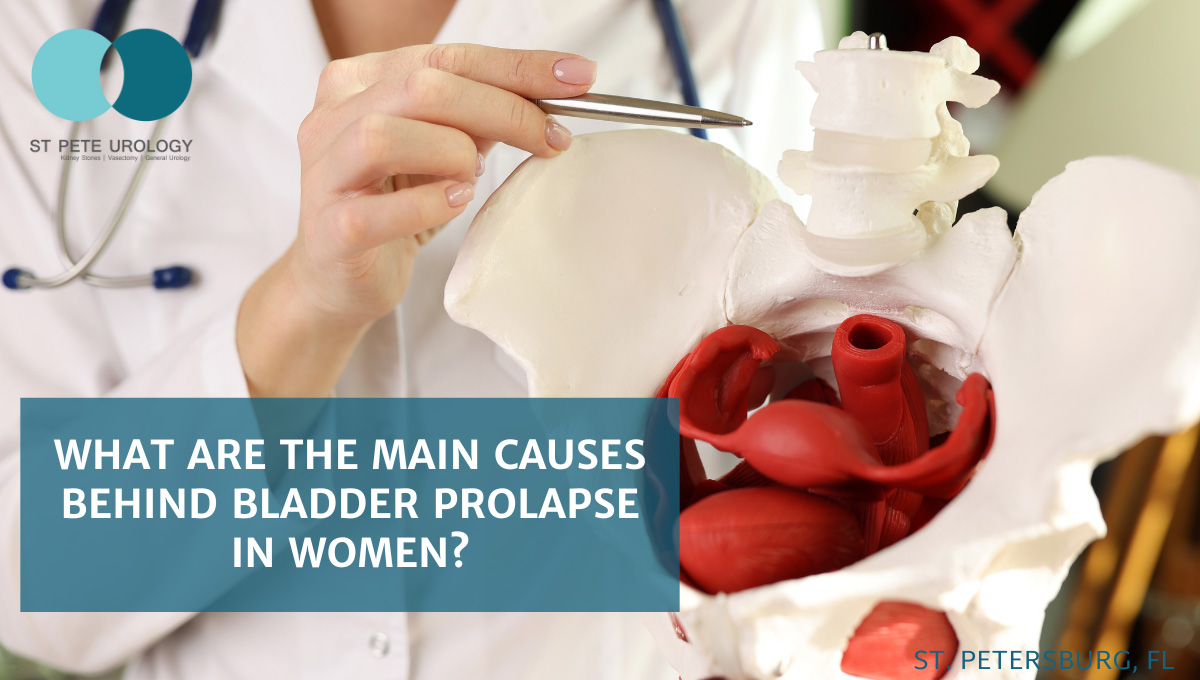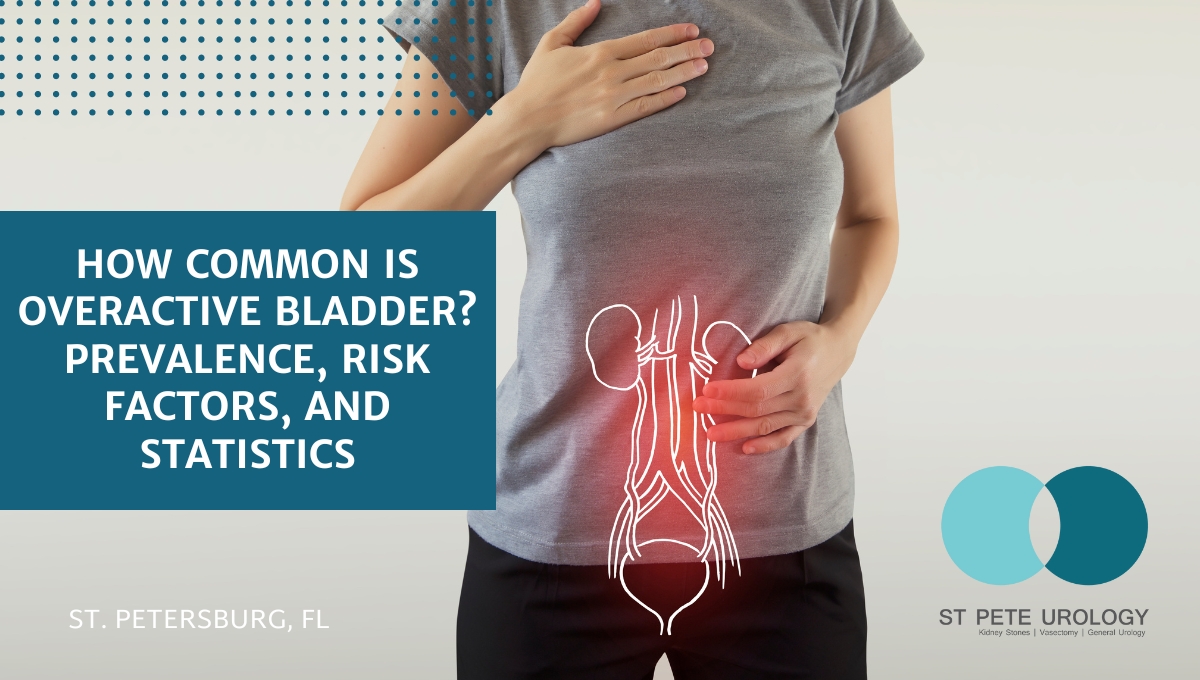Left untreated, overactive bladder can wreak havoc on daily life. Interrupted sleep, stress and anxiety are some of the effects of OAB.
Continue readingWhat Are the Early Signs of Bladder Cancer in Men and Women?
Recognizing early signs of bladder cancer is crucial. Learn symptoms, risk factors, and the importance of early diagnosis for better health.
Continue readingHow Does an Enlarged Prostate Affect Urinary Function?
How does an enlarged prostate affect urinary function? Getting UTI, bladder stones or kidney damage are just some possible symptoms.
Continue readingUnderstanding Regular Bladder and Bowel Function
Knowing the difference bladder and bowel function and dysfunction is important when understanding when to call a urologist.
Continue readingIs Your Bladder Healthy? Key Signs to Look Out For
Recognizing the key signs of a healthy bladder is important to monitor its condition and seek medical advice when necessary.
Continue readingWhat Are the Main Causes Behind Bladder Prolapse in Women?
Bladder prolapse, also known as cystocele, is a health condition that could impact a woman’s quality of life significantly.
Continue readingHow is Overactive Bladder Diagnosed? Tests and Exams You May Need
Key Takeaways:
1. OAB is a common bladder condition that affects over 200 million people globally, potentially impacting an individual’s quality of life.
2. Accurate diagnosis of OAB can be made through physical examination, bladder tests and imaging tests.
3. Treatment for OAB typically includes lifestyle changes, medications, and behavioral therapy. St Pete Urology is an excellent provider for diagnosis and treatment in the St. Petersburg area.


Diagnosis of Overactive Bladder
The first step towards an accurate diagnosis of OAB is to make a thorough patient medical history to review prior medical history and possible underlying medical conditions that could be contributing to OAB. After an initial review, a physical examination is the next necessary step. The physical examination can provide important clues as to the possible causes of the OAB symptoms. After physical examination, bladder tests and imaging tests are the most common tests used to diagnose OAB with accurate precision.
Bladder Function Tests:
To better understand the individual’s bladder functionality, bladder function tests can be carried out. This includes urine flow tests and post-void residual (PVR) tests. Urine flow tests measure the flow rate of urine and the PVR tests measure how much urine is left in the bladder after urination. These tests give important information on the type of OAB and how it is being managed.
Imaging Tests:
Additionally, if other tests yield inconclusive results, healthcare providers may employ imaging tests to diagnose OAB. These tests have the capability to display images of the bladder and urinary tract, aiding in the identification of any underlying issues. These issues may include a blocked or narrowed urethra and abnormalities in bladder muscles or valves. Also, the presence of other underlying conditions like bladder stones or tumors.
Treatment of Overactive Bladder
Once an individual has been diagnosed with OAB, treatments to manage it can be initiated. These treatments are broken down into lifestyle changes, medications, and behavioral therapy.
Lifestyle Changes:
Making lifestyle changes is always the first step to managing OAB. Lifestyle includes reducing substance use, i.e. caffeine, alcohol or other stimulants, that can irritate the bladder. Limiting intake of fluids before bed, potential allergies to certain foods, managing stress, and increasing physical activity levels can also help to reduce pain and symptoms of OAB.
Medication:
If lifestyle changes don’t provide enough relief, medications are typically the second step in the treatment plan. Although these medications can help to reduce OAB symptoms, they can also produce unwanted side effects. Therefore, it is important to review all potential risks and side effects with your doctor before taking any medication.
Behavioral Therapy:
Behavioral therapy is another treatment type for OAB. This type of therapy is designed to help individuals gain better control of their bladders. The therapy helps to build awareness of the body’s signals when the bladders have reached a certain capacity and teaches individuals to delay or prevent urge responses.
Conclusion
Overactive bladder is a condition that affects many people and can cause significant discomfort and disruption to an individual’s daily activities. Accurate diagnosis of OAB can be made through physical examination, bladder tests and imaging tests. Once diagnosis is complete, treatment can begin. Treatments for OAB typically include lifestyle changes, medications, and behavioral therapy. Early diagnosis and treatment of OAB can help to reduce symptoms and improve quality of life.
St Pete Urology is a premier urology practice and leader in diagnosing and treating OAB in the St. Petersburg, Florida area. St Pete Urology’s dedicated team of highly experienced specialists and professional staff members work together to provide you with the best possible treatment so you can get back to living a life free from OAB symptoms and discomfort.
References:
- “Urodynamic Testing: What Is It, Procedure & What To Expect.” 17 Aug. 2020, https://my.clevelandclinic.org/health/diagnostics/15684-urodynamic-testing.
- “Overactive bladder (OAB) and lifestyle modification – Female Urology.” https://www.urineincontinence.com.au/overactive-bladder/overactive-bladder-oab-and-lifestyle-modification.
- “Diagnosing Overactive Bladder – WebMD.” 7 Jun. 2022, https://www.webmd.com/urinary-incontinence-oab/overactive-bladder-making-diagnosis.
How Common is Overactive Bladder? Prevalence, Risk Factors, and Statistics
3 Key Takeaways:
1. Overactive bladder (OAB) is a common urological condition characterized by frequent, urgent urination and disruption of day-to-day life.
2. Risk factors for developing OAB include age, gender, obesity and certain medications.
3. Early diagnosis and treatment for OAB can mitigate symptoms and improve quality of life, and St. Pete Urology can provide high-quality, individualized care for those suffering from OAB.
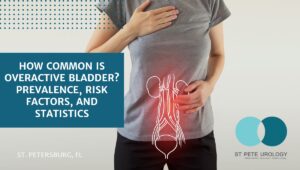

Prevalence of OAB
According to Statistic Brain, an estimated 183 million people suffer from OAB globally. Regionally, the prevalence of OAB is highest in North America, with an estimated 66.6 million people in the U.S. are currently experiencing OAB symptoms. The global and regional prevalence of OAB is largely influenced by a range of environmental and demographic factors. These factors include the aging population, rising global health awareness, sedentary lifestyle choices, and shifts in healthcare policies.
Risk Factors for OAB
There are a number of risk factors that may increase the likelihood of developing OAB. These include age, gender, obesity, urinary tract infections, strokes and other neurological diseases, diabetes, and certain medications. Studies have shown that women are more likely to experience OAB than men, with the risk increasing with age for both genders. Additionally, there is a strong correlation between obesity and OAB, with obese individuals having a higher risk of developing OAB.
Symptoms and Impact of OAB
The primary symptoms of OAB include frequent urge to urinate, urgent urination, frequent urination, and nocturia (nighttime urination). These symptoms can cause disruption in daily life, leading to difficulties with social activities, work, and maintaining relationships. Additionally, OAB can cause emotional and mental distress, leading to anxiety, embarrassment, and depression.
Diagnosis of OAB
OAB can be effectively diagnosed with a variety of tests and procedures, including physical examinations, urine tests, urine flow tests, and bladder scans. It is important to seek early diagnosis and treatment for OAB, as this can help minimize the disruption caused by the condition.
Treatment and Management of OAB
The treatment and management of OAB will depend on the individual patient, with a range of options available, including lifestyle changes, medications, bladder training, and physical therapy. It is important to discuss treatment options with a healthcare professional, as some medications may not be suitable for all patients. Additionally, lifestyle changes and self-management strategies can help to mitigate the symptoms of OAB and improve the quality of life.
Conclusion
Overactive bladder is a common urological condition characterized by frequent, urgent urination and disruption of day-to-day life. It is important to be aware of the prevalence, risk factors, and statistics associated with OAB. Key risk factors for developing OAB include age, gender, obesity, and certain medications. It is important to seek early diagnosis and treatment for OAB, as this can help to reduce the symptoms and improve the overall quality of life.
At St. Pete Urology, we strive to provide high-quality, individualized care for those suffering from common urological conditions such as overactive bladder. With our comprehensive and comprehensive approach, you can trust us to provide you with the most effective solutions for your OAB symptoms. Contact us today to schedule an appointment and get on the path to feeling your best!
References:
- “Incontinence Types & Risk Factors – Brigham and Women’s Hospital.” https://www.brighamandwomens.org/obgyn/urogynecology/types-of-incontinence-and-risk-factors.
- “Overactive bladder – Diagnosis and treatment – Mayo Clinic.” 3 May. 2022, https://www.mayoclinic.org/diseases-conditions/overactive-bladder/diagnosis-treatment/drc-20355721.
- “Urinary Incontinence risk factors – Hospital Clínic Barcelona.” 20 Feb. 2018, https://www.clinicbarcelona.org/en/assistance/diseases/urinary-incontinence/risk-factors.
Overactive Bladder and Exercise: Can Physical Activity Help or Hurt?
Key Takeaways:
1. Exercise can help to improve overactive bladder (OAB) symptoms, such as urgency and frequency of urination, involuntary leakage, and nocturia.
2. Low-impact aerobic exercise, strength training, and pelvic floor exercises can all be beneficial for people with OAB.
3. Before beginning a new exercise routine, it is important to speak with a doctor or specialist to determine the best type of exercises for the individual.


Introduction
Overactive bladder is a condition that affects both men and women, but is more common in women, especially those over the age of 40. It is defined as urinary urgency and can include the involuntary leakage of urine. Often accompanied by an urge to urinate more often than normal and nighttime urination, OAB can cause disruption to one’s daily life. Despite its prevalence, OAB often goes undiagnosed; many people don’t recognize the signs and symptoms or don’t get the appropriate treatment.
Overview of Benefits of Regular Exercise
Exercise is important for so many different reasons, both physical and emotional, and it has a myriad of health benefits. Consistent and regular physical activity can lower your risk of heart disease, stroke, mental health problems, type 2 diabetes, and some forms of cancer. Additionally, exercise can help with control of bladder pressure and manage complications from OAB. Exercises that focus on the core and hip muscles, such as abdominal crunches, squats, and Pilates, can strengthen the pelvic floor muscles, help reduce incontinence episodes, and improve bladder control.
Symptoms of Overactive Bladder
The signs and symptoms of OAB vary from person to person. Some people may experience incomplete bladder emptying, frequent urination, urgency, or nighttime awakenings due to urges and leakage. Urinary incontinence is one of the most common signs of OAB, and is defined as any involuntary leakage of urine when one is not ready or able to control or prevent it. This can occur in a variety of forms, ranging from urge incontinence (leaking with the sudden urge to urinate) to fecal incontinence (leaking of stool). Urgency is another symptom of OAB, as it is a sudden and strong urge to urinate, often without warning or a sense of control. Nocturia (excessive night-time urination) is also common in people with OAB and can disrupt one’s sleep.
Types of Exercise to Help Overactive Bladder
There are many types of exercise that can help with OAB symptoms. Low-impact aerobic exercises such as swimming, walking, and cycling are beneficial for many reasons. They are low impact so they cause less stress on the joints and muscles, but still provide a good cardiovascular workout that strengthens and tones the entire body. Strength training is also important, as it helps to build strong muscles and can improve posture, balance, and core strength. Finally, there are pelvic floor (Kegel) exercises, which are specialized exercises designed to help strengthen the muscles of the pelvic floor, which can aid in improving urinary control.
Exercise Challenges Related to Overactive Bladder
Finding the right kind of physical activity can be challenging for some people with OAB. Traditional forms of exercise such as running, jumping, and high-impact aerobic activities can exacerbate OAB symptoms or make them worse. Additionally, the fear of leakage can make it difficult for individuals to feel comfortable engaging in physical activities. Finally, OAB can cause painful symptoms that can make physical activity more difficult or even unbearable.
Conclusion
Exercise is an important part of a healthy lifestyle, and it can be beneficial for people with overactive bladder. Low-impact aerobic exercise, strength training, and pelvic floor exercises can all help improve OAB symptoms such as urinary incontinence, urgency and frequency, and nocturia. However, finding the right kind of exercise can be challenging, and dealing with the fear of leakage or painful symptoms can make exercise even more difficult. It is important to find an exercise routine that works best for the individual.
Summary of Benefits of Exercise for Overactive Bladder
Regular physical activity can provide many health benefits, and it can be a great way to manage the symptoms of overactive bladder. Low-impact aerobic exercises, strength training, and pelvic floor exercises can all be beneficial for people with OAB. However, finding the right exercise routine may be challenging and dealing with the fears and painful symptoms can be difficult. It is important to speak with a doctor or specialist to determine the best type of exercise for each individual’s situation.
Closing Thoughts
Exercise can be a great way to manage and improve the symptoms of overactive bladder. However, it is important to speak with a doctor and/or specialist before beginning a new exercise program to ensure it is appropriate for your condition. If you live in the St. Petersburg area and are looking for help managing OAB symptoms through specialized exercises, St Pete Urology specializes in helping people with OAB find the right kind of exercise routine to improve their health.
References:
- “Focus on Fitness: Exercising With Bladder Problems – Today’s Dietitian.” https://www.todaysdietitian.com/newarchives/1118p56.shtml.
- “Urinary Incontinence: 4 Exercises For An Overactive Bladder.” 10 Sep. 2021, https://mytexashealthcareobgyn.com/well-woman-care/urinary-incontinence-4-exercises-for-an-overactive-bladder/.
- “What Is Overactive Bladder (OAB)?.” https://nafc.org/overactive-bladder/.
What Should You Eat with Overactive Bladder? Diet Tips and Foods to Avoid
3 Key Takeaways:
1. Eating foods high in fibre such as leafy greens, legumes, and whole grains can help improve OAB symptoms.
2. Staying hydrated by drinking enough water regularly can also help reduce OAB symptoms.
3. Exercising regularly can help strengthen the muscles in the bladder and improve OAB symptoms.


What is an Overactive Bladder?
An overactive bladder (OAB) is a condition that affects the bladder by causing sudden, uncontrollable urges to urinate, even when your bladder is not full. These sudden urges can make everyday life uncomfortable and difficult, leading to embarrassment, and lack of time to get to a bathroom quickly. Common symptoms of overactive bladder include an urgent and frequent need to urinate, a feeling of not being able to hold onto the urine, and an increased need to “go” at night.
Potential Causes of Overactive Bladder
Your diet is one of the most influential factors in your bladder health. Certain nutrients in foods can have an influence on your urinary tract and bladder, including some minerals and vitamins. Additionally, certain foods may promote overactive bladder, including foods and drinks that are high in caffeine and artificial sweeteners. Furthermore, unhealthy eating habits, such as skipping meals and eating later in the day, may also play a role in the development of bladder issues.
To help improve OAB, it’s important to look at the foods and beverages you’re consuming and make changes to your diet. Here are some diet tips that may help improve your OAB.
Foods That Can Help Improve Overactive Bladder
To improve your overactive bladder, it’s important to focus on adding certain healthy goodies into your diet. Eating certain herbs and spices, such as turmeric and ginger, may help reduce inflammation in the bladder and provide relief of OAB symptoms. Fruits and vegetables, such as apples, bananas, and carrots, may also provide relief of symptoms. Additionally, including some whole grains in your diet, such as brown rice and oatmeal, may help improve OAB symptoms.
Changes in Diet and Lifestyle That Can Help Reduce Symptoms of Overactive Bladder
In addition to including more fruits and vegetables in your diet, adding fibre can also help improve OAB. Fibre soaks up water, which can help with controlling bladder urges. Eating foods high in fibre like leafy greens, legumes and whole grains can help with improving the OAB symptoms.
Drinking water is also key for controlling OAB symptoms. Staying hydrated throughout the day helps keep your body running, and in turn, helps regulate your bladder. Drinking enough water regularly can help reduce OAB symptoms.
Finally, getting regular exercise is important for improving OAB. Exercise helps strengthen the muscles in the bladder, which in turn may help to stop unwanted bladder urges. Getting regular physical activity can help improve OAB symptoms.
Conclusion:
In conclusion, diet and lifestyle modifications can be effective tools for improving overactive bladder. Eating a balanced diet full of fruits and vegetables, whole grains, and adding fibre to help with water absorption, can help reduce OAB symptoms. Also, drinking enough water to stay hydrated is key for controlling OAB, and getting regular exercise can help strengthen the muscles in the bladder.
At St Pete Urology, we understand how difficult and embarrassing an overactive bladder can be. Our team of experts can help provide advice and options for improving and managing your bladder issues. Contact us today to learn more about how we can help.
References:
- “Frequent Urination in Men and Women: Causes & Treatments.” 15 May. 2021, https://www.webmd.com/urinary-incontinence-oab/frequent-urination-causes-and-treatments.
- “Bladder control: Lifestyle strategies ease problems – Mayo Clinic.” https://www.mayoclinic.org/diseases-conditions/urinary-incontinence/in-depth/bladder-control-problem/art-20046597.
- “Overactive Bladder (OAB): Causes, Symptoms & Treatment.” 13 Sep. 2022, https://my.clevelandclinic.org/health/diseases/14248-overactive-bladder.


